5 eco-friendly trends in modern construction
As the world becomes increasingly aware of the environmental impact of traditional construction practices, the industry is shifting towards more sustainable methods. Eco-friendly construction not only benefits the environment but also offers long-term cost savings, improved health for occupants, and compliance with stricter regulations.
The construction sector is embracing sustainability as a core value, recognizing the need to minimize its carbon footprint and reduce waste. This shift is driven by consumer demand, environmental regulations, and the economic benefits of green building practices.
Implementing eco-friendly construction practices is crucial for reducing greenhouse gas emissions, conserving natural resources, and creating healthier living spaces. It also aligns with the global movement towards sustainable development goals.
1. Green Building Materials
Modern construction is increasingly utilizing materials that are either recycled or sourced from renewable resources. This includes the use of reclaimed wood, recycled steel, and bio-based materials, which help to reduce the environmental impact of new constructions.
Low-VOC (volatile organic compounds) paints, adhesives, and sealants are becoming standard in the industry to improve indoor air quality and reduce harmful emissions.
2. Energy Efficiency and Renewable Energy
Smart architectural design that maximizes natural light and promotes passive heating and cooling can significantly reduce a building's energy consumption. Passive solar building design is a key aspect of this, utilizing the building's orientation, insulation, and materials to maintain comfortable temperatures.
The integration of solar panels, wind turbines, and other renewable energy systems into buildings is becoming more common, helping to reduce reliance on fossil fuels and lower energy costs.
3. Water Conservation and Management
Water-saving fixtures, rainwater harvesting systems, and greywater recycling are all methods being employed to conserve water in modern construction projects.
Green infrastructure solutions like permeable pavements, green roofs, and rain gardens are being used to manage stormwater runoff, reducing the risk of flooding and water pollution.
4. Sustainable Landscaping
Landscaping with native plants and xeriscaping—designing landscapes to reduce or eliminate the need for irrigation—are trends that complement eco-friendly construction by conserving water and supporting local ecosystems.
Green roofs and living walls not only enhance biodiversity and improve air quality but also provide additional insulation, reducing energy costs for heating and cooling.
5. Advanced Building Technologies
BIM technology allows for more efficient planning, design, construction, and management of buildings, reducing waste and improving collaboration among stakeholders.
Automation and prefabrication in construction can lead to faster build times, less waste, and improved precision, further contributing to the sustainability of construction projects.








Comments (0)